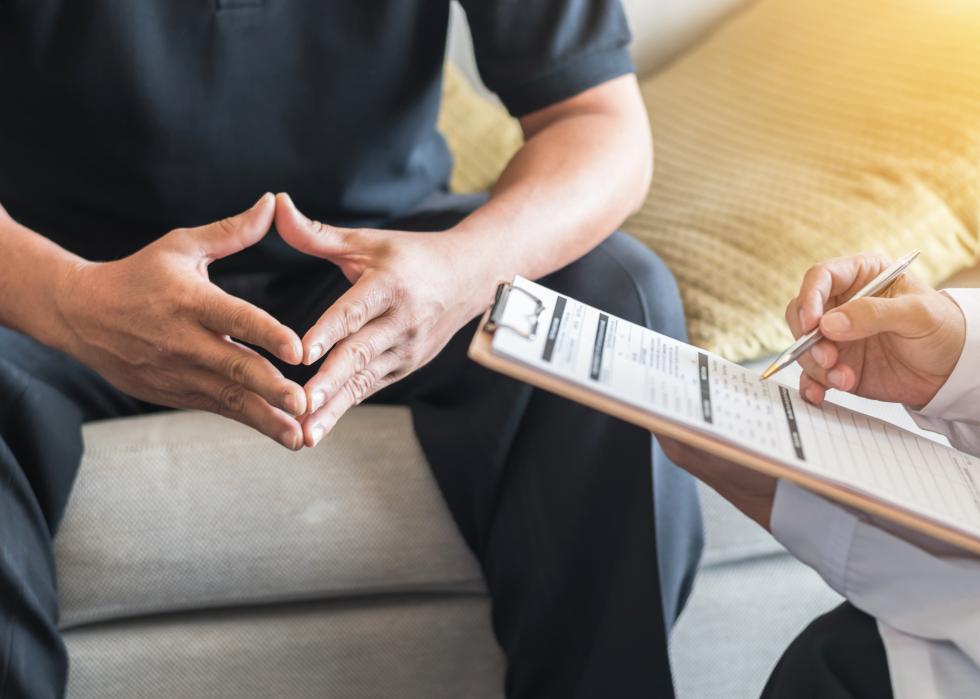
5 facts about mental health care during the first year of the pandemic
This story originally appeared on Foothold Technology and was produced and distributed in partnership with Stacker Studio.
5 facts about mental health care during the first year of the pandemic
The COVID-19 pandemic has had a significant impact on mental health in America, the full scope of which is still unfolding. Social isolation, the shutdown of schools and businesses, and restrictions on in-person health care services became the new normal by mid-2020. Yet even before the pandemic, mental health advocates raised concerns over the mental health needs of Americans.
For that reason, Foothold Technology identified five insights about mental health and mental health care during 2020, using data from the Substance Abuse and Mental Health Services Administration.
One in 5 people live with a mental health issue, according to findings from a 2020 SAMHSA study. This and other similar statistics serve as a catalyst for the agency's mental health awareness campaigns; however, the pandemic made the need for mental health care increasingly more apparent. Shortly after it began, many more people experienced mental health problems due to physical distancing, stigma and discrimination, and job losses in some of the hardest-hit areas.
Unfortunately, the rise in the prevalence of mental health problems during the pandemic coincided with severe disruptions to mental health services, leaving huge gaps in care for those who needed it most. For much of the pandemic, services for mental, neurological, and substance use disorders were the most disrupted of all essential health services, according to the World Health Organization.
While the impacts of these disruptions were noticeable across the board, they were more extreme for young people who were made to stay at home, increasing the risk of family stress and abuse—both risk factors for mental health issues. Women also faced greater stress at home, with one study showing increased domestic violence after lockdowns began.
Read on to learn five enlightening takeaways concerning mental health care one year into the COVID-19 pandemic.

A majority of Americans said the pandemic negatively impacted their mental health
More than half of the population aged 18 or older reported that COVID-19 had a negative impact on their emotional or mental health, according to SAMHSA. The data shows that people with existing mental health problems and those with severe mental illness were more likely to report that the pandemic had an impact on their mental health. For some, this negative outcome was due to the fear that they or their loved ones would become sick. The economic downturn and anxiety of unemployment also contributed to the mental health crisis during the pandemic. All of these factors combined adversely affected a lot of Americans.

1 in 10 people said they were unable to access mental health care
During the pandemic, there was a "staggering" gap between the number of Americans who needed care for mental health conditions and those who actually received it. SAMHSA's report showed 38.7% of U.S. adults experienced delays or cancellations in receiving mental health services during the first year of the pandemic. Although several mental health programs for screening, preventive and intervention services were established in public areas around the country, tight measures taken to contain the pandemic often interrupted them, leaving those in need without access to mental health treatment.
In different ways, the fallout from the lack of mental health care echoed throughout people's lives. Drug overdose fatalities climbed to new highs during the pandemic, according to the Centers for Disease Control and Prevention. Research also found an increase in personal relationship issues.

Cost was the most common barrier to mental health treatment
Access to mental health care is a major concern for many Americans. More than half of the adults in the United States with a mental illness (roughly 27 million people) go untreated.
During the pandemic, SAMHSA reported that cost was the leading reason Americans did not receive mental health treatment. And it can be expensive—a standard 60-minute treatment session might cost anywhere from $65 to $250 for people with or without insurance. A more severe diagnosis, of course, comes with higher costs. For many people, a lack of financial means is a big barrier to getting treatment; others may have inconsistent or insufficient care due to not having the financial means to continue their prescribed care plans.

Adults over 50 were less likely to transition to online mental health appointments
Even though the COVID-19 pandemic affected the mental health of many adults, people over 50 who did not regularly use computers struggled to access health care when providers moved appointments and booking systems online. Social care was also limited, which worsened social isolation. These changes impacted older people's physical, mental, and emotional health and well-being. The fact that most people over 50 are not tech-savvy and may not be familiar with the technology necessary to take advantage of these new health care options is a big reason why they could not access valuable online mental health therapy and other forms of health care during the pandemic.

1 in 6 people reported delays in receiving prescriptions for mental health needs
For many people, having prescriptions mailed to their homes was previously a more consistent and convenient method of receiving them; Americans who had their medication delivered, however, experienced more delays in receiving it during the pandemic. Almost all large pharmacies now provide a mailing option, which increases the potential for delivery and quality problems. Sixteen percent of adults experienced delays in receiving their prescriptions during the global health crisis, SAMHSA reported. While one or two missed doses may not seem like much, it can have a substantial impact on an individual's response to treatment.



